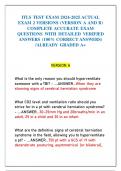ITLS TEST EXAM 2024-2025 ACTUAL
EXAM 2 VERSIONS (VERSION A AND B)
COMPLETE ACCURATE EXAM
QUESTIONS WITH DETAILED VERIFIED
ANSWERS (100% CORRECT ANSWERS)
/ALREADY GRADED A+
VERSION A
What is the only reason you should hyperventilate
someone with a TBI? - ....ANSWER...When they are
showing signs of cerebral herniation syndrome
What CO2 level and ventilation ratio should you
strive for in a pt with cerebral herniation syndrome?
- ....ANSWER...30-25mm Hg and 20breaths/min in an
adult, 25 in a child and 30 in an infant
What are the definitive signs of cerebral herniation
syndrome in the field, allowing you to hyperventilate
a pt? - ....ANSWER...TBI pt with a GCS of <9 with
decerebrate posturing, asymmetrical (or bilateral),
,dilated, or non-reactive pupils, or a pt who initially
has a GCS of <9 but drops by two points.
What do bilateral dilated and fixed pupils normally
represent? - ....ANSWER...brain stem injury, which is
91% fatal
If the patient has signs of herniation and the signs
resolve with hyperventilation, should you continue
hyperventilation? - ....ANSWER...No
How should an open skull fracture be treated? -
....ANSWER...adequate oxygen and maintain
perfusion, wound dressed without excessive
pressure
What is a cerebral contusion and what are the signs
of one? - ....ANSWER...bruised brain tissue, alteration
of LOC, weakness, speech problems, personality
changes, stroke symptoms
What is a subarachnoid hemorrhage and what are
the signs and symptoms? -
....ANSWER...intravascular fluid leaking into the brain
causing edema - severe headache, coma, vomiting
,What is a diffuse axonal injury? - ....ANSWER...the
brain is injured so diffusely that there is a
generalized edema, presenting in unconsciousness
with no focal motor defects
What is an anoxic brain injury? - ....ANSWER...injury
to the brain due to lack of oxygen
What is the no-reflow phenomenon -
....ANSWER...inability of restoring oxygenation and
blood pressure to restore perfusion to the cortex
after an anoxic episode of 4-6 minutes or more, with
the exception of hypothermic pts.
Signs and symptoms of an acute epidural
hematoma? - ....ANSWER...ICP signs, lapses of
consciousness, body paralysis on opposite side,
dilated and fixed pupils on side of injury, rapid death
Signs and symptoms of an acute subdural
hematoma? - ....ANSWER...slow acting ICP, headache,
fluctuations in LOC, focal neurological signs (stroke
like signs)
, What level of the GCS score indicated severe brain
injury? - ....ANSWER...8 or lower
Difference between shock and head injury with ICP?
- ....ANSWER...Shock has narrow pulse pressure,
hypotension, tachycardia, tachypnea. ICP has
widened pulse pressure, hypertension, bradycardia,
and dyspnea.
What is a primary spinal cord injury? -
....ANSWER...injury to the spinal cord that occurs at
the time of the trauma itself
What is a secondary spinal cord injury? -
....ANSWER...Injury that occurs from hypotension,
generalized hypoxia, injury to blood vessels,
swelling, compression of the cord surrounding
hemorrhage, or injury to cord from movement of a
damaged and unstable spinal column
What is neurogenic shock? - ....ANSWER...shock
caused by spinal injury in which the connections of
the spine to the adrenal glands are interrupted and
the vasoconstrictors, epi and norepi, are not
produced. Without these the blood vessels dilate and




